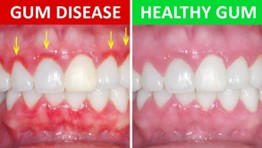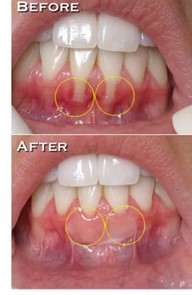What is gum?
The pink tissue around your teeth is called gum or gingiva.
What is gum disease and how is it detected?
Gum disease is detected by your dentist during the dental health check by using an instrument called BPE probe or CPITN probe which is used to measure the space between the gum and tooth, also known as pocket. The dentist will score the BPE between 0 and 4, with 0 referring to very healthy gum with minimal pockets and 4 with a very deep pocket (3.5mm and more).

Some of most common reasons for gum disease are plaque build-up, smoking, chewing tobacco, family history (one of the most common is diabetes). Some medications can also cause gum diseases such as anti-depressants and anti-hypertensives. To prevent or reduce the risk of gum disease is recommended to brush your teeth twice a day (morning and evening) or, when possible, after every meal, with a soft manual toothbrush or electric toothbrush, and to use interdental brushes or floss. It is also recommended to have a professional clean performed by the Hygienist at least every six months. Not everyone has the same level of gum disease, that’s why we can divide the progression of gum disease in four different stages and three different grades with associated levels of stability.

The early stage of gum disease is called Gingivitis, where the gum appears red and puffy with a presence of bleeding while brushing and flossing and possible bad breath. This is usually treated with a regular hygiene visit and improving your cleaning at home. This is not gum disease in its purest sense as it is a reversible condition with no long term implications.
The second stage is called Early Periodontitis, where the gums are red and swollen, bleeding when brushing and flossing, persistent bed breath, slight bone loss and possible tooth mobility. At this stage the dentist will recommend you to increase the hygiene visits (every 3-4 months) and If hygiene visits are not enough, your general dentist will recommend you to see a Periodontist, which is a dentist specialized in gum problems.

The third stage is called Moderate Periodontitis. Gums are more inflamed and puffy, bleeding spontaneously, persistent bed breath and taste, moderate bone loss with teeth mobility and root exposed. At this stage it is very important to see a gum specialist, have a full mouth assessment and start a treatment plan that will involve a full mouth deep clean before it will evolve to stage 4. In most cases, to make the treatment more pleasant for the patients, local anaesthetic is required.
The last stage is called Advanced Periodontitis, where teeth appear longer, severely wobbly and there is a high chance of losing them. In some cases, to save as many teeth as possible it is necessary to lose the least cleanable teeth in the mouth, most common are the Wisdom teeth and 2nd molars. One thing that the Periodontist will explain before starting the treatment is that having a regular deep cleaning will not be enough to help healing the gum disease if you’re at home cleaning won’t improve and if you don’t reduce or discontinue smoking. The treatment can significantly reduce the pockets and in some instances some bone can return, but gum will usually not grow back.
What is Gum Graft?
After the treatment is completed and the mouth is stable and healthy the Periodontist can advise the patients to have gum surgery also known as gum graft. This consists in taking the necessary amount of tissue form the palate and place it where the gum is missing. The healing process will take up to three months and during this time it is very important to keep the area clean and healthy and follow the Periodontist’s advice. This procedure is not always successful as the tissue may not integrate with the rest of the gingiva but in some severe cases it is worth a try.

Diagnostic Chart used by dentists.
The chart is a technical staging and grading flowchart used by dentists and specialists to diagnosis and categorise gum disease. It is published and approved by the British Society of Periodontology and our London cosmetic dentists at Marylebone Smile Clinic use it when assessing your dental health.
FAQs
Does gum disease affect general health?
Yes, it can affect and negatively impact the body through the bloodstream and can contribute to conditions including heart disease, stroke and respiratory problems.
Is there a cure for gum disease?
It is not curable, and can only be managed. This means the gum disease can return to being inactive rather than cured entirely. There is always a risk of it returning.
Is gum disease preventable?
Yes, it can be avoided with regular dental care as well as thorough home care. Your dentist will be able to provide detailed advice.
Is gum disease hereditary?
Yes, gum disease can be hereditary and linked to one or both sides of your family.
Can I smoke and avoid gum disease?
It depends on how many cigarettes are smoked in a day and if the are combined with alcohol. For people suffering from gum disease and with family history, is recommended not to smoke.
Are there any mouthwashes for gum health?
Yes, chlorhexidine in the antiseptic that is included in Corsodyl mouthwash. It can be effective only as an adjunct to active treatment and must be used at a concentration of 0.2%. Regular use can cause cosmetic problems so use with the advice of a cosmetic dentist.
Do dogs get gum disease?
Yes, and it is very poorly managed unfortunately. Dogs have a different diet to humans, but there is a requirement for cleaning around the gums. Dog toothbrushes fit around your finger, and dog toothpaste acts as a dentifrice and to help your pet tolerate the cleaning. The alternative is to use something like Dentastix.

Can you get gum problems after COVID-19?
Not that we or the dental profession is aware of, however, the virus is relatively new and research on its effects on oral health will be ongoing. Watch this space!
Can a tongue/lip piercing cause gum loss?
Yes, a tongue piercing is often made of metal or a tough plastic and it irritates the gum on the lower front teeth. Over time, the gum retreats or recedes due to this. Our recommendation is to discontinue wearing it if you notice changes around your gum.
Can gum be lost from an implant?
Yes, this can occur from implant disease, sometimes called peri-implantitis. It is essentially gum disease involving an implant and can cause loss of the implant if it is not addressed swiftly. Contact your implant dentist or gum specialist immediately if you notice gum loss around an implant.
Are there gum problems after menopause?
Menopause affects the physiology across the entire body, and some of the anecdotal effects are increased sensitivity around the teeth and increased friability of the gums. This means that the gums can bleed more often and more easily than before.
What is the Perio Pill?
The Perio Pill is an approach of using adjunctive antibiotics to assist the resolution of the gum disease. It can only be prescribe by a dentist and is only useful in certain cases when used in addition to other supportive therapies.
What is the Perio Chip?
The Perio Chip is a product that can be implanted into diseased sites to release an antiseptic called Chlorhexidine. It theoretically helps neutralise bacteria that cause gum disease, however, in practice it is not considered a first or second line approach and is seldom used by specialists.
Will I lose my teeth if they are wobbly?
It depends on how severe the mobility is. In same cases teeth can be saved with specialist treatment from a periodontist and improving the cleaning at home. In some cases teeth are badly compromised by the periodontitis and is advisable to have the tooth/teeth extracted.
Can braces make my gums worse?
During the orthodontic treatment, especially if wearing fixed brae, teeth and gum are more difficult to clean and it is possible to develop gingivitis. This should be easily addressed by seeing the hygienist regularly, brushing teeth after every meal and using interdental brushes and super floss after every meal.
Can I get the gum back that is lost from gum disease?
Unfortunately, the gum lost from gum disease won’t grow back after treatment, but it can be improved surgically with gum grafting or gingival veneers.
What is a gum specialist?
A gum specialist, known as Periodontist, is a dentist specialized in prevention and treatment of gum diseases (periodontal diseases). They undergo 3-4 years of additional training and research to manage gum disease, gum lifts and gum graft in the best possible manner.
Want to know more?
Get in touch to enquire about our services or to book an appointment.



